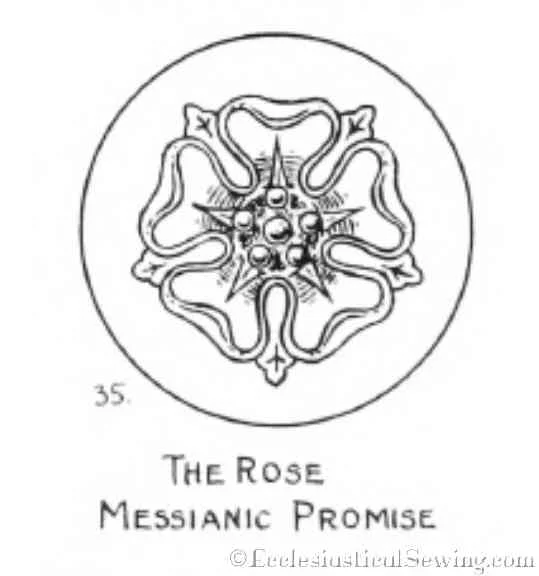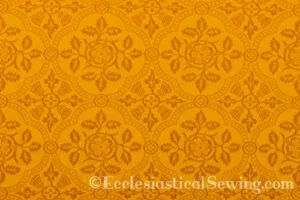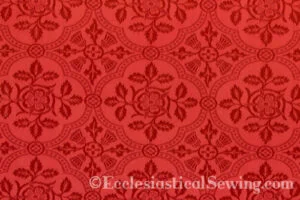Cloister Liturgical Fabric
Cloister Liturgical Fabric
Cloister Liturgical Fabric: As the new Ecclesiastical Sewing Website launch date approaches, I thought it would be nice to have a few feature posts to highlight some of the beautiful liturgical fabrics that will soon be available for sale. But the usual way of uploading photos in the blog posts does not seem to be the best way to show off these lovely church vestment fabrics. I admit that I am not very tech-savvy, so I’ve been trying to find a better way to upload a collection of photos for viewing. Of course, many of you may be saying right about now, “Use a photo gallery…doesn’t she know that yet?……..” Well, now I do, and in time, I hope to continue to learn and be able to update the site more. So thank you for your patience in the process.
The Liturgical Fabric Cloister
The subject for this photo gallery is the Liturgical Fabric Cloister. Cloister is a piece-dyed fabric which means the color is completed after the weaving is done. The fabric is originally woven as “grey” goods without the use of dye. Once the weaving is complete, the fabric is dyed to the desired colors. This method of manufacture is useful in that it allows for an affordable liturgical fabric at an introductory price point. The drawback of this method of manufacturing is that it limits the depth of color. They had vivid colors, but they often lacked the richness of color found in more expensive church vestment fabrics.
Cloister is a reversible symbolic pattern that dates from around the year 1900. If one looks closely, it is easy to see the two main design features of the Scottish Thistle and the English Rose which were popular at that time. Cloister is a lighter-weight ecclesiastical fabric that would work well for making stoles, chasubles, tunics, dalmatics, chalice veils, and other vestment pieces. Cloister would work well with machine embroidery when the proper stabilizers and backings are used.
Usages
In addition to the colors below, Cloister is available in Roman Purple, Violet, and white. The cloister is also frequently used in the making of University robes in the United Kingdom. The pattern repeat is small, making Cloister a little easier to work with than some of the larger pattern repeats found in other ecclesiastical fabrics. Cloister is a fabric that has grown in my estimation over time. The design elements found in Cloister are steeped with hundreds of years of history. The English Rose was the emblem that played a prominent role in English History during the 30 years of the War of the Roses. While the English Rose’s history dates back centuries, the Scottish Thistle has an even older history. The rose and the thistle also have a liturgical significance.
The Rose Messianic Promise
“The Rose. This refers to the prophecy of Isaiah, where it is stated that the desert shall blossom as the rose at the coming of the Kingdom of Righteousness. The rose is said to date back only to the thirteenth century. It is used in a conventional form as in Figure 35, and seldom in a naturalistic manner. The rose is extremely common in Gothic wood carving, and many a bench end is adorned with it. It is a common charge of heraldry. The wild rose details at Amiens Cathedral, somewhat less conventionalized, are among the finest examples of perfect sculpture extant.” – F. R. Webber, Church Symbolism*
“Thorns and thistles, woven together, represent the curse placed upon the earth……” – F. R. Webber, Church Symbolism*
When one takes the time to really look at a liturgical fabric, one can see the thought and” care that was taken to include symbols and design elements that are filled with symbolic meaning in the history of the church. For those interested in learning more about Church Symbolism, I recommend Rev. F. R. Webber’s book Church Symbolism.
I hope you enjoy looking at a few of the liturgical colors available in the Cloister Pattern.
Solo Dei Gloria
Be sure to visit our online store front Ecclesiastical Sewing where you may shop for Liturgical Fabrics, altar linen fabrics, church vestment-making patterns, liturgical machine embroidery designs, church vestment trims and notions and so much more. You may also find us on Ecclesiastical Sewing on Facebook, Twitter, and Pinterest. Sign up for our mailing list at the bottom of the page on our online store front and receive a free copy of our Small Linens Booklet as our way of saying thank you for following along.
*Webber, F. R. (1938) Church Symbolism. Cleveland. J. H. Jansen, Publisher.
The Christmas Rose Legend & Symbolism
Pentecost a Season of Red Liturgical Fabrics
Thistle and Thorn Lattice Liturgical Stole by Edward Riojas
“INRI”, “Jesus, the King of the Jews”











 RSS - Posts
RSS - Posts
Hi Carrie,
I was wondering if you’d found an American supplier for your brocades? I’m only familiar with an English company.
Hi Cynthia,
The liturgical brocades will all come from the United Kingdom. I have found an America Company that has a few nice brocade patterns and may add those to my line in time, but for now the brocades will come from England. The quality of the English brocades is very nice and they are lovely to work with. The thread count is very high so most work well with either hand or machine embroidery, like the brocades from ages past.
Thanks for following along.
Carrie
Will you be selling samples of the fabrics so that we can show our preists and deacons what the fabrics look like ? (am new to liturgical sewing and that would help me decide what to buy)
Hi Agnes,
Yes, I will be selling fabric swatches, and would encourage everyone to use swatches to show their priests and others the colors and fabric options that are available. The swatches also are a good way to check the quality and “hand” of a fabric. I am working on swatches this weekend, as well as stole kits and will be sure to have updates when everything is ready.
Best regards,
Carrie